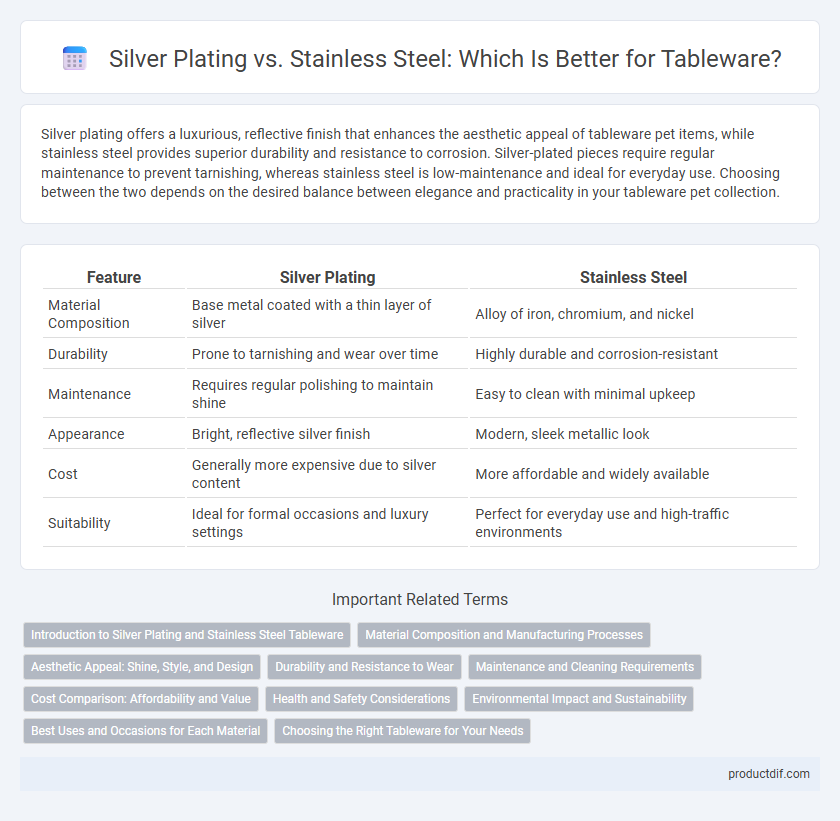Silver plating offers a luxurious, reflective finish that enhances the aesthetic appeal of tableware pet items, while stainless steel provides superior durability and resistance to corrosion. Silver-plated pieces require regular maintenance to prevent tarnishing, whereas stainless steel is low-maintenance and ideal for everyday use. Choosing between the two depends on the desired balance between elegance and practicality in your tableware pet collection.
Table of Comparison
| Feature | Silver Plating | Stainless Steel |
|---|---|---|
| Material Composition | Base metal coated with a thin layer of silver | Alloy of iron, chromium, and nickel |
| Durability | Prone to tarnishing and wear over time | Highly durable and corrosion-resistant |
| Maintenance | Requires regular polishing to maintain shine | Easy to clean with minimal upkeep |
| Appearance | Bright, reflective silver finish | Modern, sleek metallic look |
| Cost | Generally more expensive due to silver content | More affordable and widely available |
| Suitability | Ideal for formal occasions and luxury settings | Perfect for everyday use and high-traffic environments |
Introduction to Silver Plating and Stainless Steel Tableware
Silver plating enhances tableware with a luxurious, reflective finish and antimicrobial properties, making it ideal for formal dining settings where elegance and hygiene are paramount. Stainless steel tableware offers durability, resistance to corrosion, and ease of maintenance, providing a practical and modern alternative suitable for everyday use. Both materials balance aesthetics and functionality, with silver plating favored for ornate presentations and stainless steel prized for its robustness and versatility.
Material Composition and Manufacturing Processes
Silver plating involves coating a base metal, often copper or nickel, with a thin layer of pure silver through electroplating, enhancing aesthetic appeal and antimicrobial properties. Stainless steel tableware is crafted from an alloy containing primarily iron, carbon, chromium, and nickel, offering superior corrosion resistance and durability through precision forging and machining processes. The manufacturing of silver-plated items requires careful control of plating thickness to ensure longevity, while stainless steel production emphasizes alloy composition and heat treatment to achieve strength and rust resistance.
Aesthetic Appeal: Shine, Style, and Design
Silver plating offers a lustrous, mirror-like shine that enhances the elegance and sophistication of tableware, making it ideal for formal settings. Stainless steel features a sleek, modern finish with a subtle sheen that complements contemporary and minimalist designs. The choice between silver plating and stainless steel impacts the overall aesthetic, with silver's ornate appeal contrasting against stainless steel's durable, versatile style.
Durability and Resistance to Wear
Silver plating offers a luxurious finish but tends to wear off over time, especially with frequent use and washing, reducing its durability compared to stainless steel. Stainless steel is highly resistant to corrosion, scratches, and daily wear, making it an ideal choice for long-lasting tableware. Its robust composition ensures consistent strength and minimal maintenance, outperforming silver-plated options in everyday durability.
Maintenance and Cleaning Requirements
Silver-plated tableware requires gentle cleaning with non-abrasive, mild detergents to prevent tarnishing and avoid wearing down the delicate plating. Stainless steel tableware offers easy maintenance, as it is resistant to rust, corrosion, and scratches, allowing for dishwasher-safe cleaning and less frequent polishing. Proper care for silver plating involves regular polishing with specialized silver polish, whereas stainless steel only needs occasional wiping to maintain its shine and durability.
Cost Comparison: Affordability and Value
Silver plating offers an elegant, high-end appearance at a moderate price point but requires regular maintenance to prevent tarnishing, impacting long-term value. Stainless steel provides superior durability and corrosion resistance at a lower initial cost, making it a more affordable option for everyday use. When comparing cost-effectiveness, stainless steel delivers greater value through longevity and minimal upkeep, while silver plating is ideal for occasional, formal settings where aesthetic appeal is prioritized.
Health and Safety Considerations
Silver plating offers natural antibacterial properties that help reduce bacterial growth on tableware surfaces, enhancing hygiene during use. Stainless steel is corrosion-resistant and non-reactive, ensuring food safety by preventing metal leaching, especially with acidic foods. Both materials require proper cleaning to maintain their health benefits and prevent contamination.
Environmental Impact and Sustainability
Silver plating offers a classic aesthetic and antimicrobial properties but involves mining and chemical processes that contribute to environmental pollution and resource depletion. Stainless steel, prized for its durability and recyclability, presents a more sustainable alternative with a lower overall environmental footprint due to its long lifespan and ease of recycling. Choosing stainless steel tableware supports circular economy principles by reducing waste and conserving raw materials compared to the energy-intensive silver plating process.
Best Uses and Occasions for Each Material
Silver plating offers an elegant, classic look ideal for formal dinners, weddings, and special occasions where sophistication is key. Stainless steel provides durability and low maintenance, making it perfect for everyday use, casual dining, and outdoor events. Both materials serve distinct purposes, with silver plating suited for impressive presentations and stainless steel excelling in practicality and longevity.
Choosing the Right Tableware for Your Needs
Silver plating offers a luxurious and elegant finish ideal for formal dining, but it requires careful maintenance to prevent tarnishing and scratches. Stainless steel tableware provides superior durability, corrosion resistance, and ease of cleaning, making it perfect for everyday use and high-traffic settings. Choosing the right tableware depends on balancing aesthetics with practicality based on your dining environment and frequency of use.
Silver Plating vs Stainless Steel Infographic

 productdif.com
productdif.com